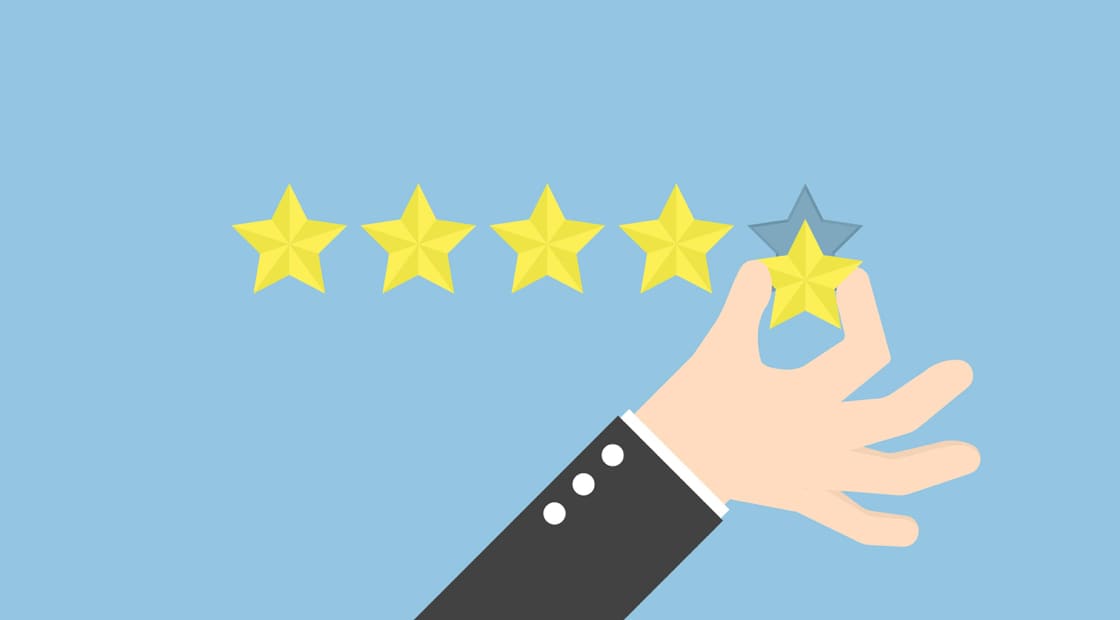In inbound marketing, we focus heavily on creating the right content to attract and convert new leads. Does it offer real value to readers? Is the voice on brand? Are we meeting the customer at the appropriate place in the buyer’s journey?
We can’t say "yes" to any of these questions if we neglect the fundamentals of on-page SEO. In fact, we limit the chance that the content we’re creating will be more visible in Google and rank highly in search results.
We host Richmond’s HubSpot User Group (also known as a HUG) where we exchange ideas with inbound marketers in the local community. At our last HUG meeting, shared with the group some best practices in on-page SEO.
In my talk, I walked through what SEO really means, why it’s so important, and what SEO techniques you can use to optimize your website’s content. Here are just a few nuggets from the presentation about best SEO practices.
Skip the explanations and go straight to the on-page SEO tips
What Is SEO Anyway?
SEO, short for search engine optimization, is best defined by Moz as “the practice of increasing the quantity and quality of traffic to your website through organic search results.”
To break down this definition even further, let’s start with quality of traffic.
If you’re familiar with the inbound methodology, you might have heard the term “qualified leads.” A qualified lead is simply a person who matches your company’s ideal buyer profile. The idea for quality of traffic is similar to that of a qualified lead.
This aspect of the definition refers to getting traffic to your site from visitors that are more likely to become customers. This means you should include content on your site that meets the needs of the people you want to attract and sell to. So, if you’re claiming to sell items or services on your website that do not make sense to your business (like gel pens when you’re only selling pencils) you’re not going to get qualified traffic.
Quantity of traffic means you have more of the right people clicking to your website from the search engine results.
Organic search results are listings that are not paid ads. It's the ones that Google identifies as good content and that show up without having to pay for the link.
On-Page Vs. Off-Page SEO: What's the difference?
You'll hear people talking about SEO mention "on-page" and "off-page" tactics. Here's a slide that explains these two principles:
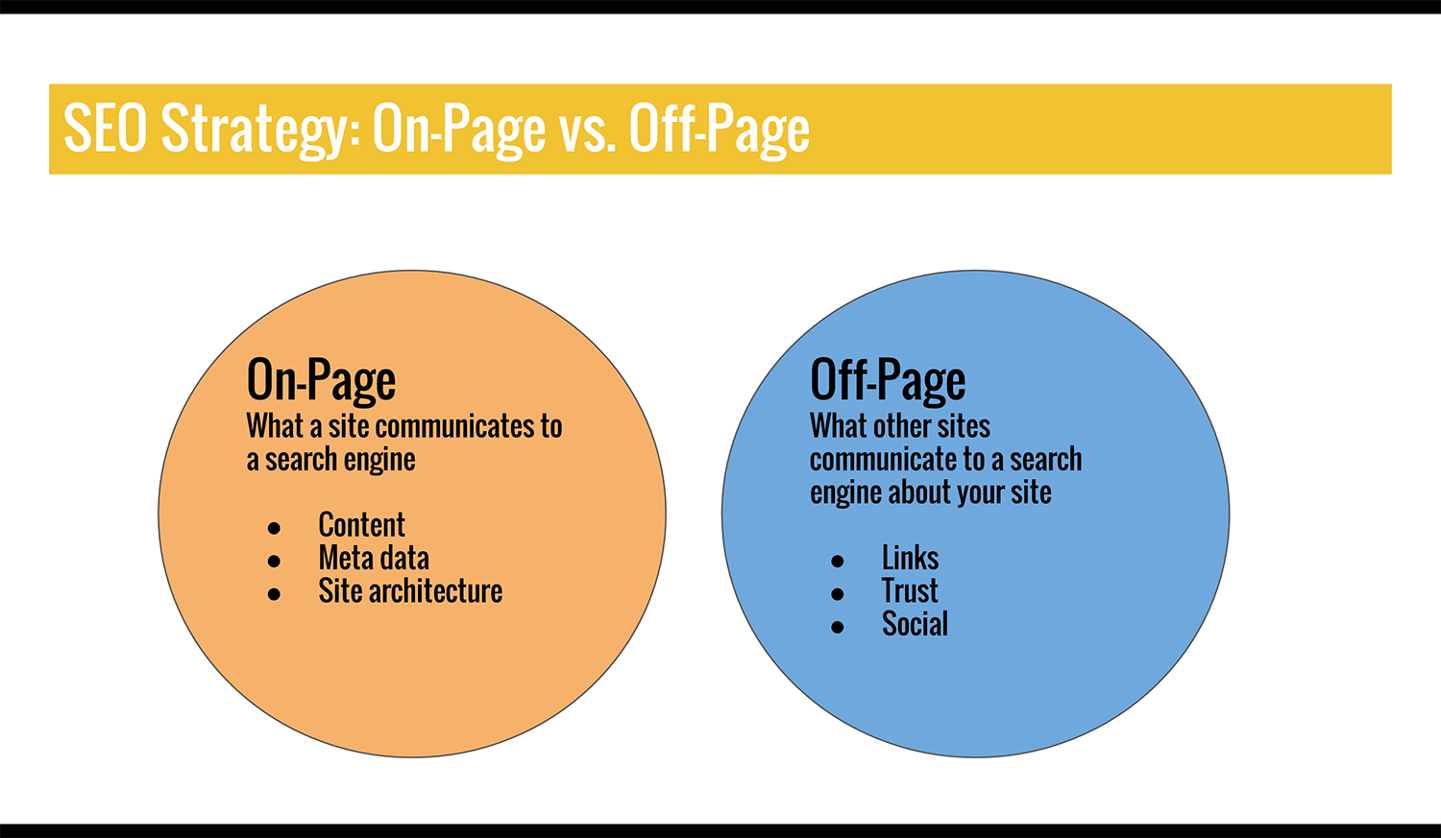
On-page refers to optimizing how your website communicates to search engines. The content of your website tells Google what you’re all about. This helps the search engine determine what topics and information your company is knowledgeable about. There are several ways to accomplish good on-page optimization. Here are a few:
- Create great content
- Optimize metadata (like title tags)
- Create a good website information architecture
- Improve technical aspects of your website, like redirects, page speed, compression, caching, etc.
Off-page refers to what other websites communicate to search engines about your website. Your backlink profile, or all the sites that currently link to yours, has a lot to do with off-page optimization. Off-page tactics take into consideration the quantity and quality of the links pointing back to you.
When performing off-page optimization, you might ask these questions:
- Are the links coming to your site spammy or are they high quality?
- Do the number of inbound links infer that your site is often looked to as a trusted authority on a specific subject?
- How long has your domain been active?
- Does your website have lots of shares on social networks?
Essentially, Google will look to how visitors (for social sharing) and other websites send signals about your website to determine if it's a trustworthy source of information.
These tactics are by no means the only things you can do to rank better in search engines. But they can improve your inbound marketing immensely, ensuring properly optimized web content so users really understand the purpose of your website and find it helpful.
Remember: the better the user experience, the better chance visitors will stay and read more pages, find helpful information, be convinced of your company's expertise and attract more qualified visitors.
This presentation and the remainder of this article will focus on on-page optimization tips and basic SEO techniques. For the purpose of the article, I will assume that you’ve already done keyword research for your business. The article will guide you on what to do with those keywords and where to put them.
So, let’s dive in!
Tip 1: Make Sure You Have Great Content
Does anyone care about your content?
Have you ever searched for something on Google, only to click through from a search result to a site and find useless information? It’s frustrating, and you'll probably leave that website to find the next best thing. Don’t be that website. Make people care about what you have to say! So, how do you do that? Simple. Learn to satisfy a demand.
Here’s a real life example of how a digital marketer did just that:
A freelance marketer from Hustle and Grind wrote a case study and how-to guide on how to grow your Instagram followers quickly. This marketer saw a demand for information about how to grow a social media following.
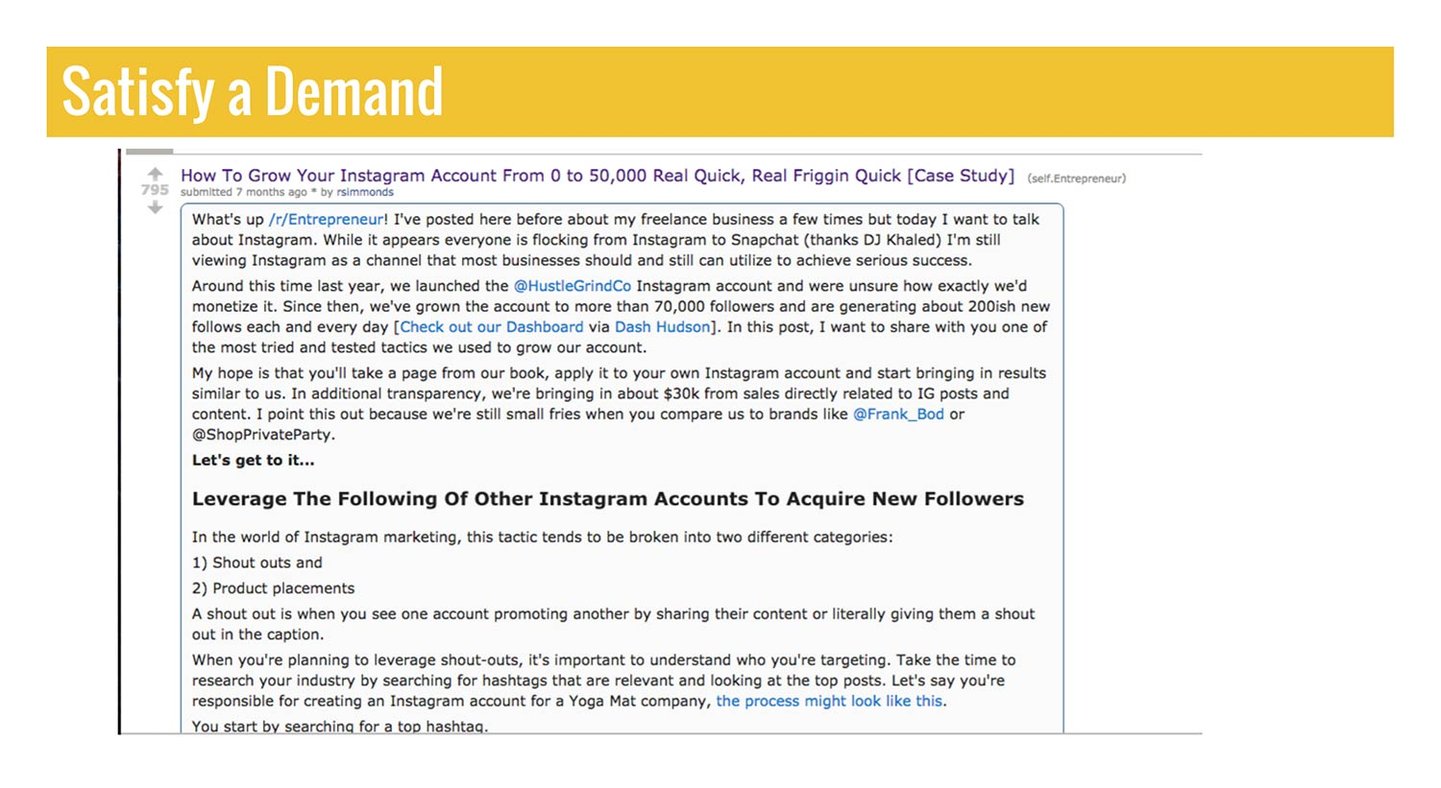
He saw there was a demand for this type of information and posted it. The post has since started lots of conversations and even provided the marketer more leads for his business.
So, how do you apply this to your business? Think about your customer personas. What are their challenges? What problems do they have? Once you figure those things out you can easily brainstorm the types of content that can help solve a problem they have. In doing this, you’ll earn their trust and respect. They may even come to your blog for even more advice, which will allow you the opportunity to nurture a relationship with them.
Tip 2: Add Target Keywords to Page Titles
Now that you've written some great content, it’s time to optimize it. Before hitting publish, make sure your targeted keywords are in the right places. In addition to having them in the content itself, you'll want to make sure that the target keyword is found in your page title.
A page title is an HTML element (<title>) to describe the topic of a web page. You’ll notice that when Google indexes your page, the title will show up as the blue clickable link. For example, this result comes up when you search for “Richmond HubSpot”:

Why is this so important? Will this have a great impact? Absolutely, yes! The right page titles can be the difference between someone clicking through to your site or skipping it to find something better to click on.
Updating page titles are usually easy depending on your content management system. If you use HubSpot, you can easily update the page title as you edit the web page itself. If you're using Wordpress, install an SEO plugins like Yoast to update your page title and find out if it is optimized for your target keyword.
How do you write great page titles?
Writing great page titles is part art and science. You want to balance being unique and compelling while also adhering to some basic rules. Let’s go through what those rules are:
- Write concise titles. The amount of characters from search engine to search engine vary, so I'd recommend between 50-60 characters (including spaces) to be safe. This ensures you’re meeting the guidelines of multiple search engines.
- Include the target keyword at the beginning of the page's title. Let’s say your company sells discount Apple laptops. When writing your page title for that page, place the target keyword “Macbook Deals” toward the beginning of your title and not at the very end. You want to catch the searcher’s eye quickly. Don’t risk having a search engine omit the keyword (more than likely the searcher will end up skipping your search result and click through to something that seems relevant to them).
- Every page on your website should have unique page titles. Using the same page title for every page is terrible for your search visibility. Your site rankings will suffer and you’ll lose the opportunity to get more traffic. Duplicate page titles will cause your pages to compete with each other to rank for the exact same phrases and search engines will end up providing less relevant results.
Tip 3: Add Targeted Keywords in Meta Descriptions
Meta descriptions are an HTML attribute that provide concise explanations of the contents of web pages. Meta descriptions are commonly used on search engine results pages to display preview snippets of a given page.
While meta description tags aren’t an SEO ranking factor, they are extremely important in getting people to click-through from search engine listings.
How Do You Write Great Meta Descriptions?
- Descriptions should be no more than 155 characters
- Use target keywords naturally
- Make the descriptions compelling to get searchers to click (use questions, mystery, call-to-action, offer value to the searcher)
- Make sure the meta description is relevant to the page and page title
- Don’t forget to make them unique
An example of a well optimized page title and meta description
Let’s say you’re searching for a good burger here in Richmond, Virginia. How might you search? More than likely you’d search for something like “best burgers Richmond VA.” When I do this, this search result catches my eye. Not bad by our standards, right?
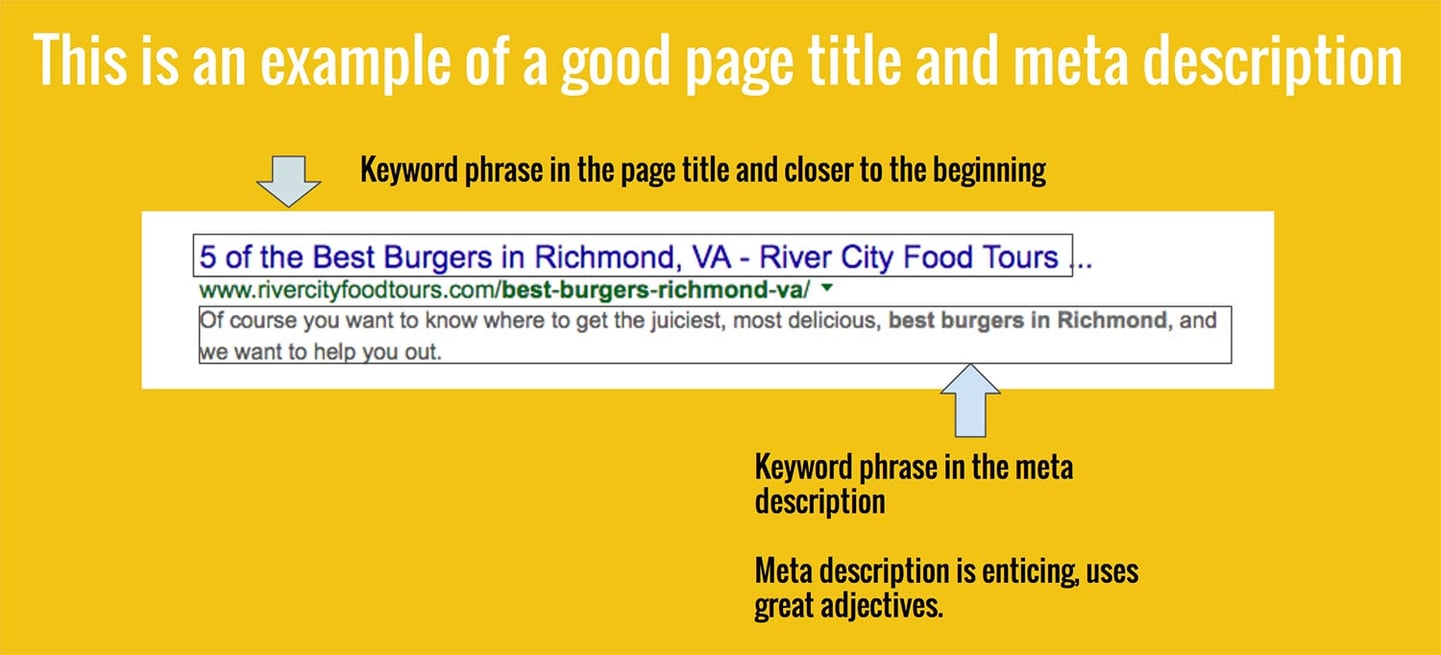
You see that the keyword phrase is in the page title and is visible to the user. It’s used naturally and the meta description is written in an enticing manner.
Tip 4: Optimize Your URLs
Next, you should ensure that your URLs are optimized. Going back to our "best burgers in Richmond" example, let’s take a look at the better search result. What do you notice about this URL? It has the keyword phrase and it’s the right length. There aren’t stop words in the URLs and it’s clear what the page is about.
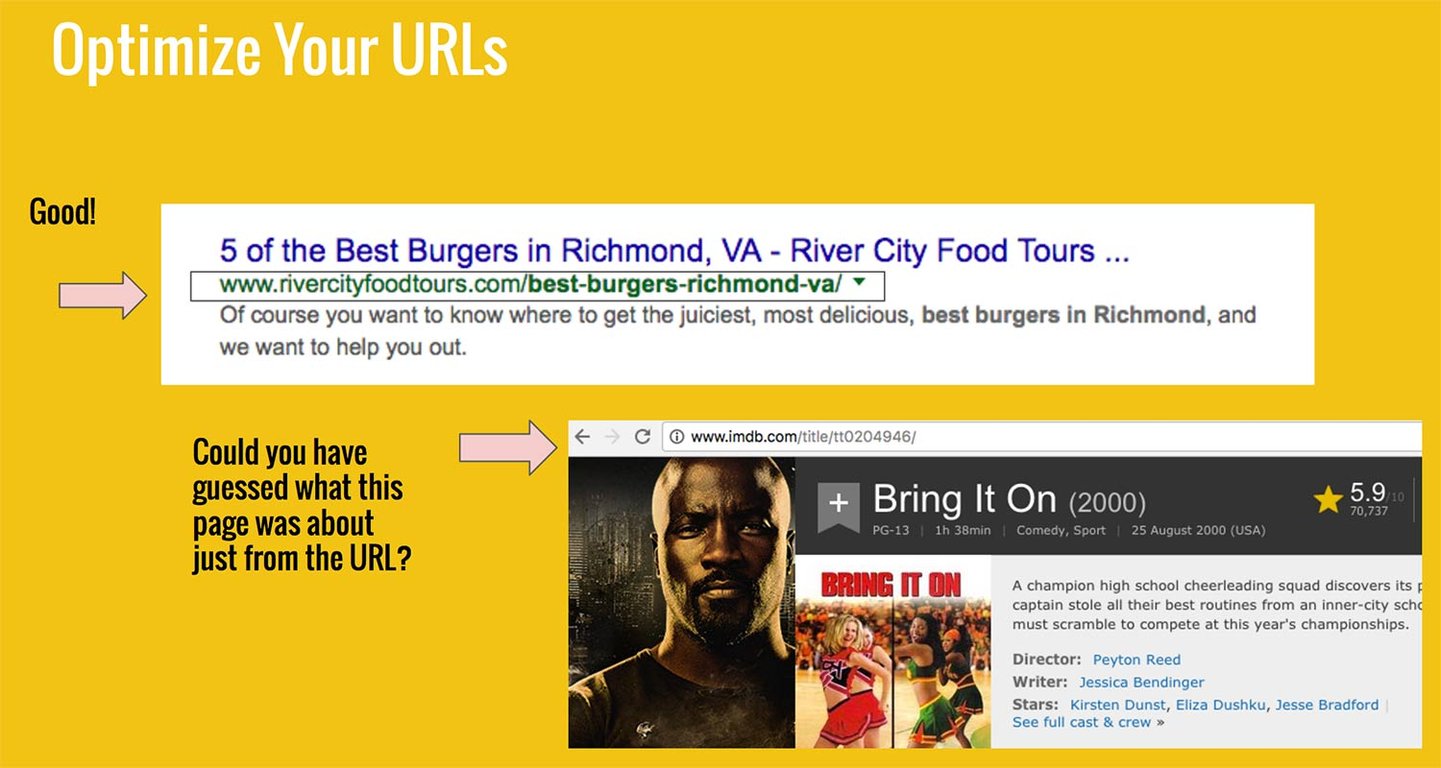
Look at this second example above. Could you have guessed what this page was about just from the url? Also notice the hierarchy of the information. Search engines and users can determine the page is on the IMDB website, but can’t determine what the page is about.
Tip 5: Use the Right Anchor Text When Linking Internally
Anchor text is the wording you use in links in a web page or blog post. When writing your anchor text, make sure you’re writing them properly.
Keys for Proper Anchor Text
- Avoid saying things like “click here” if you can. Instead, use keywords related to the page you’re linking to.
- Remember that search engines use anchor text as an indicator of a page topic.
- If your anchor text says “most delicious burgers in Richmond,” the page should definitely point to a page that discusses that topic and not something completely different.
Tip 6: Use Keywords in Image Alt-Text
Alt-text is an HTML attribute for images that provides alternative information (namely, a description) for an image. A visitor might see alt-text if an image is unable to load or if the visitor is using a screen reader.
Tips for using alt-text in images
- Use keywords naturally within the image alt-text.
- Make sure the keywords are relevant to the image.
- Avoid keyword stuffing -- cramming random, irrelevant keywords in the alt-text.
- Alt-text has a low impact on SEO, but still worth optimizing when you have time because images can be found through image searches.
Tip 7: Make Sure Your Content Is Linkable and Shareable
For niche B2B companies, great content is linkable and shareable. Why, is this important?
People are lifelong learners. They want to be educated, and find educational content helpful during a B2B sales process. Educational material is more important to niche B2B companies more than any other industry.
If your content is not helpful, then search engines will most likely not rank it well. You’ll miss out on an opportunity to bring in more traffic to your website.
This includes content that lives behind lead forms (we call this "gated" content). While gated content works to generate leads, you should think critically about which pieces of content you want to put behind a lead form and which you want to be made more accessible for our visitors and to Google. Going through this thinking process is an essential best SEO practice.
Keys for Linkable Content
- Make content accessible (not all content should be gated).
- Content that’s not linkable will be unlikely to rank well.
- Your website should include ways to share content on social media. When your content is posted to social media, it sends a vote of credibility to search engines.
Final Thoughts on On-Page SEO Practices
This is by no means the end-all-be-all list for on-page SEO best practices, but it is a good place to start. If your company needs more visitors to get more leads and more sales, then on-page SEO and basic SEO techniques like these are a good place to start.
If you'd like to find out how important SEO should be in your digital strategy, let's talk. We love solving problems and talking all things inbound. What questions do you have? Leave them in the comments below.

